AR
RIV
IN G?
Migration,
Faith and
Identity
18.07.
-23.10.2025
AR
RIV
IN G?
Migration,
Faith and
Identity
18.07.
-23.10.2025
EX HIB
I TION
Migration is a defining feature of our past and present: Individuals have time and again left their homes, either of their own free will or by necessity. Faith often plays a central role in people setting out for a new place, being on the move, and settling down: It knows no nations or borders, provides support in new situations, and fosters a sense of community. Constance is a vivid example with respect to both migration and faith: People from the most diverse backgrounds have been migrating to and from the city since ancient times. Even today, many traces of religious traditions and practices are visible in the cityscape. When people arrive, migration, faith, and identity combine to create something new – something that we want to make visible and tangible with this exhibition.
St ory
tell ing
We guide you through the process of arriving over the four floors of the Turm zur Katz. We take you from leaving home to being on the move and address what it means to have truly arrived.
Using concrete life paths and personal stories, we show not only how migration and faith characterize the lives of individuals, but also how they have changed the cityscape of Constance.
We also explain how local experiences are part of global developments.
St ory
tell ing
We guide you through the process of arriving over the four floors of the Turm zur Katz. We take you from leaving home to being on the move and address what it means to have truly arrived.
Using concrete life paths and personal stories, we show not only how migration and faith characterize the lives of individuals, but also how they have changed the cityscape of Constance.
We also explain how local experiences are part of global developments.
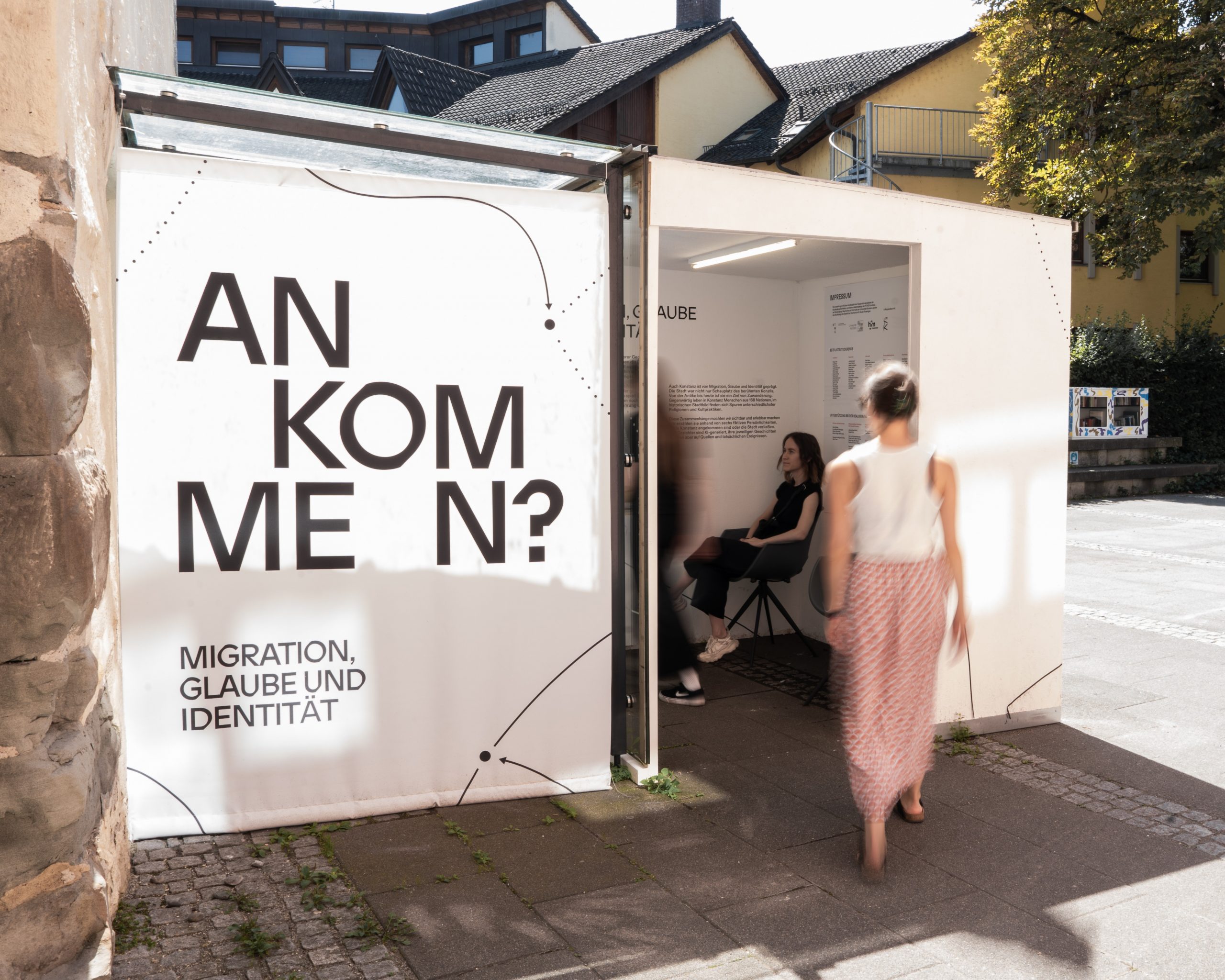
REGI STRA TION
OF FICE
At the registration office, you will receive a personal ID – your identity document for visiting the exhibition.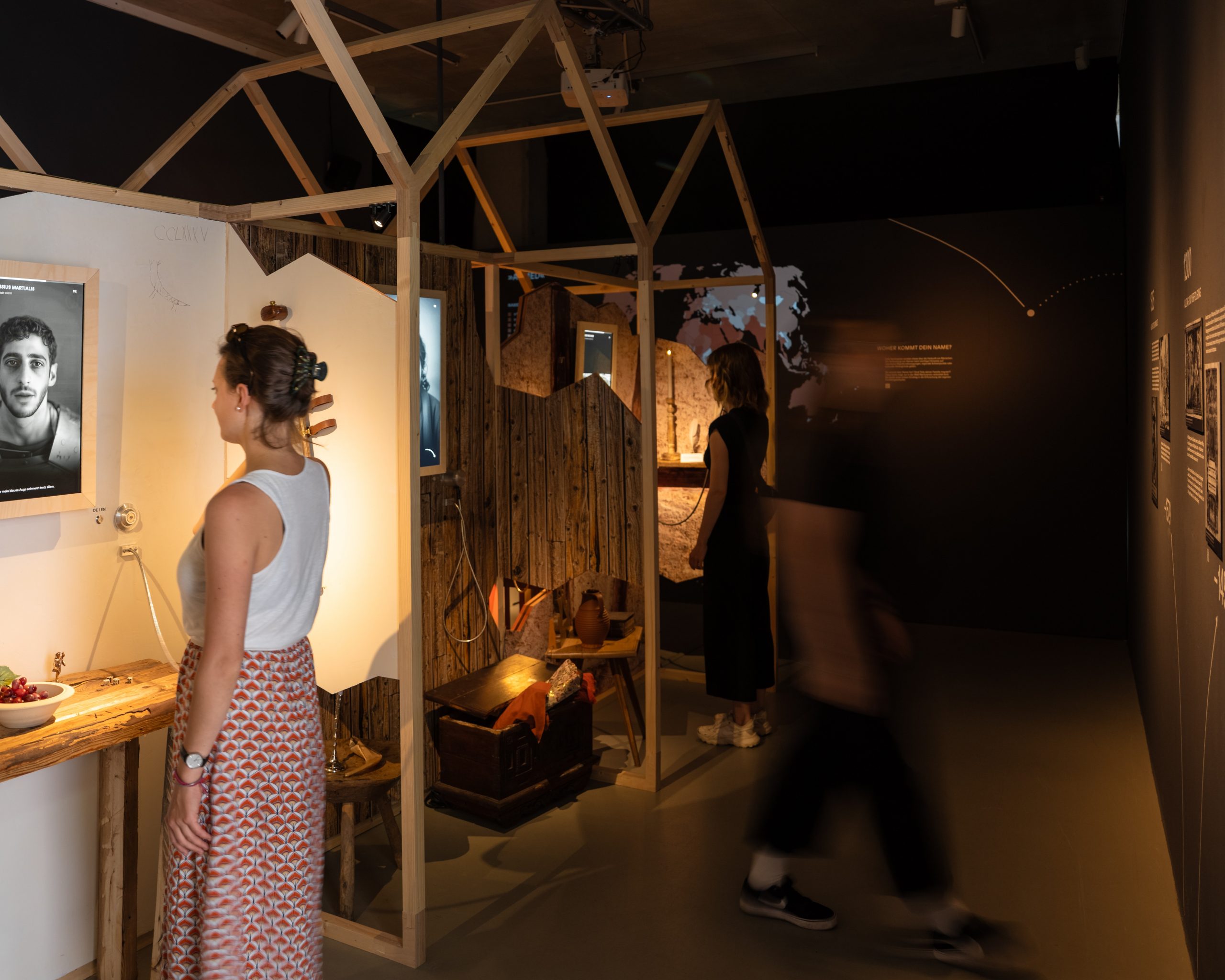
HO
ME
On the ground floor, you will learn about the stories of six individuals – people with different backgrounds and experiences. What led them to leave their homes?
The characters presented are inspired by historical figures and have been developed using AI technology.
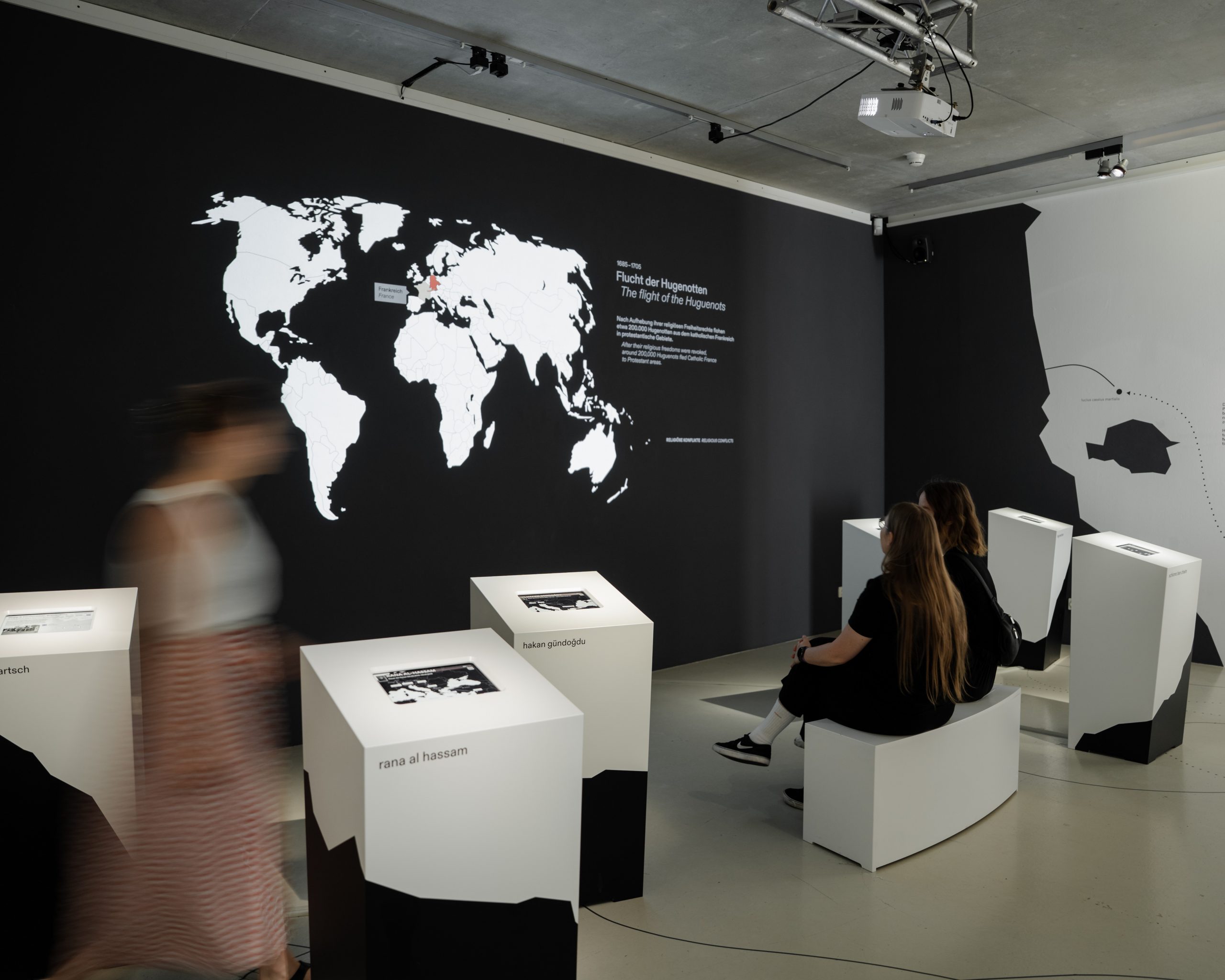
JOU RN
EY
This floor tells stories of departure, transformation, and the journey itself – of people who left their homelands in search of a new future. We invite you to explore migration across different eras and perspectives, and to see the experience through the eyes of those who lived it.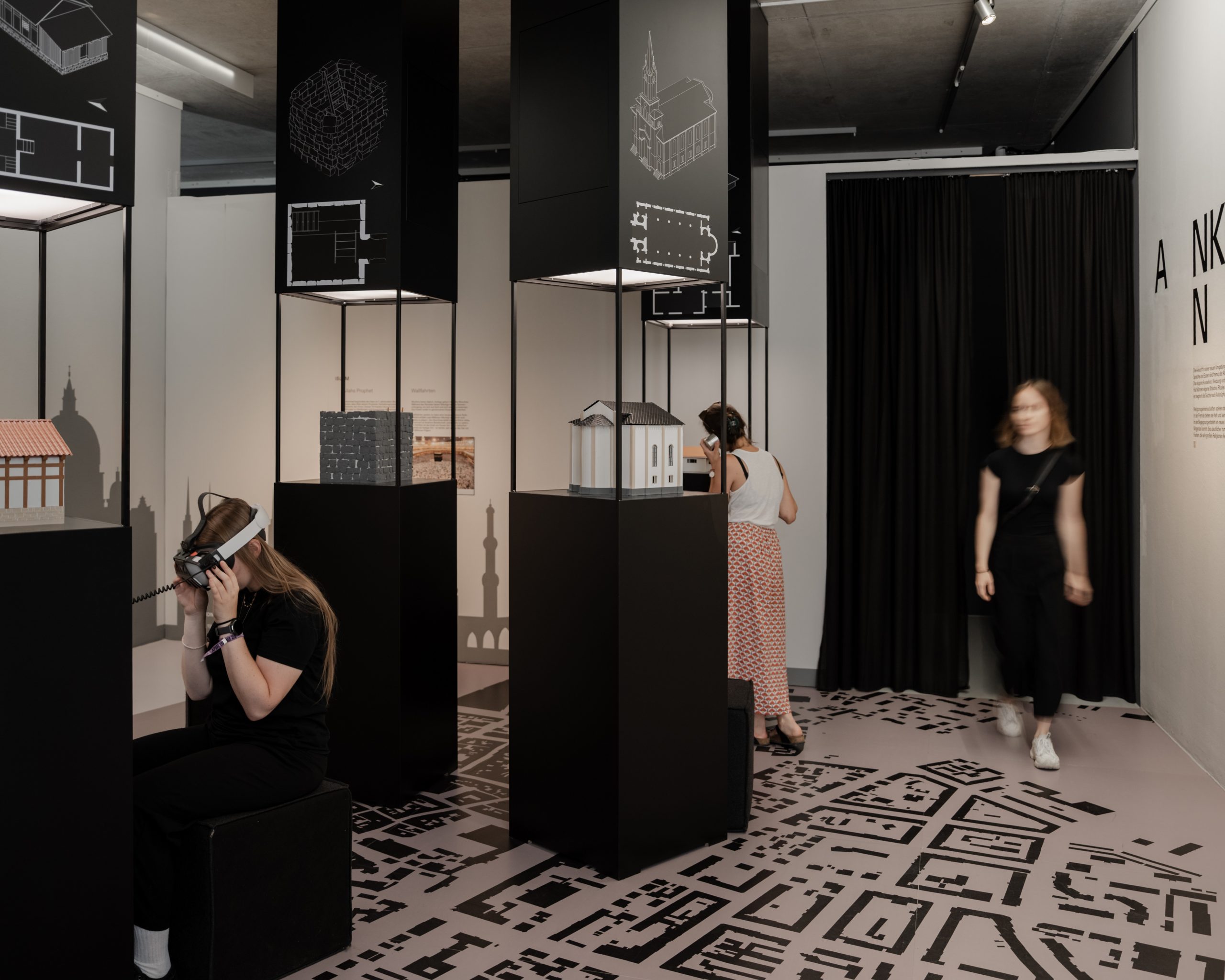
AR
RIV AL
At the centre of this level are religious sites. They offer orientation, community, and support. Using VR technology, you can explore Constance’s religious venues.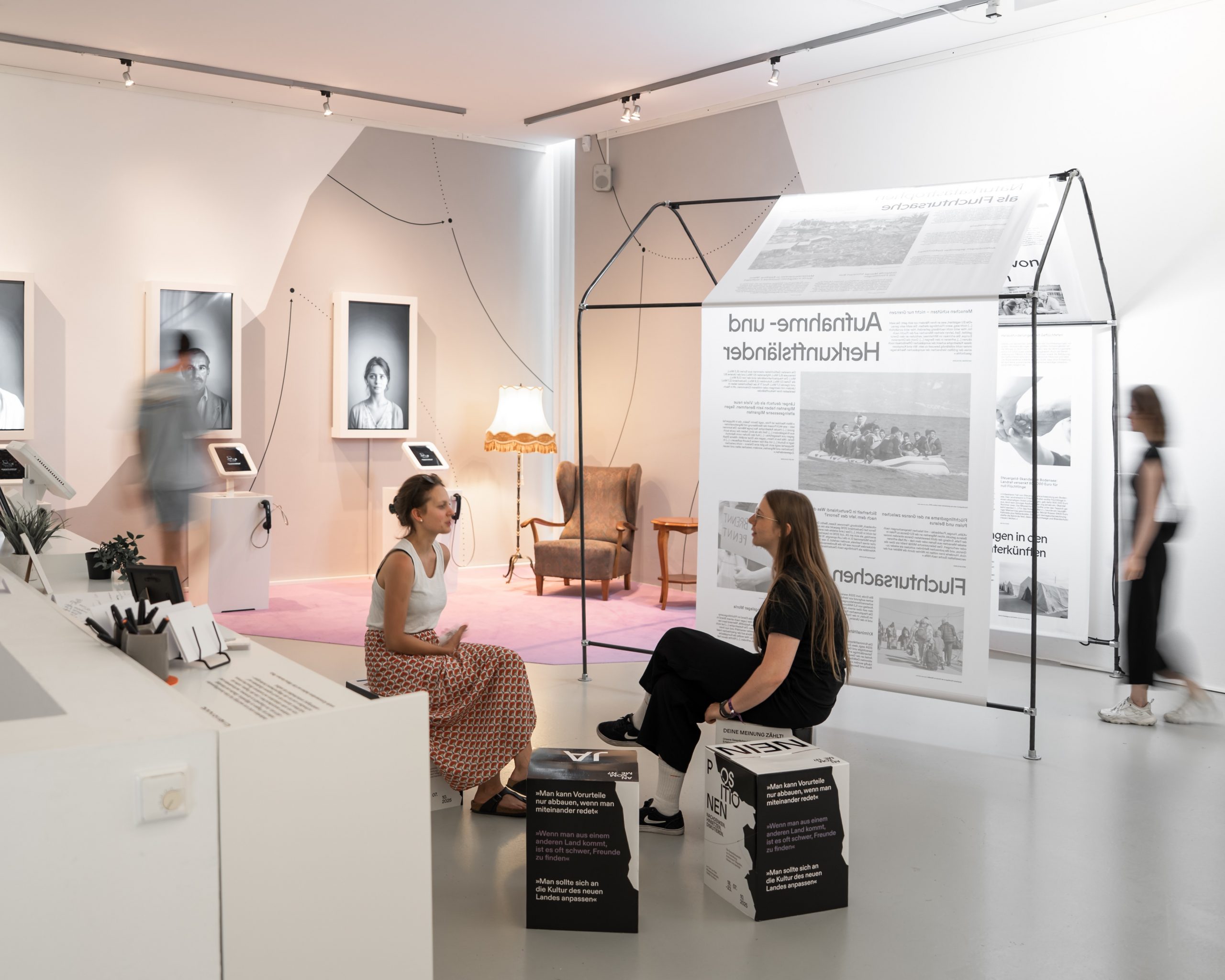
AR RI
VED?
The top floor is dedicated to the question of what it means to have truly arrived. Talk to the AI-animated characters about their fate, visit a refugee tent, and mark your favourite place in Constance. What does it mean to you to have truly arrived?IN
SIGHTS
With the assistance of AI, virtual reality, and interactive maps, the exhibition raises questions and offers space for visitors to find their own answers. It reveals what often remains hidden: personal fates, individual decisions, and global connections.

REGI STRA TION
OF FICE
At the registration office, you will receive a personal ID – your identity document for visiting the exhibition.
HO
ME
On the ground floor, you will learn about the stories of six individuals – people with different backgrounds and experiences. What led them to leave their homes?
The characters presented are inspired by historical figures and have been developed using AI technology.

JOU RN
EY
This floor tells stories of departure, transformation, and the journey itself – of people who left their homelands in search of a new future. We invite you to explore migration across different eras and perspectives, and to see the experience through the eyes of those who lived it.
AR
RIV AL
At the centre of this level are religious sites. They offer orientation, community, and support. Using VR technology, you can explore Constance’s religious venues.
AR RI
VED?
The top floor is dedicated to the question of what it means to have truly arrived. Talk to the AI-animated characters about their fate, visit a refugee tent, and mark your favourite place in Constance. What does it mean to you to have truly arrived?IN
SIGHTS
With the assistance of AI, virtual reality, and interactive maps, the exhibition raises questions and offers space for visitors to find their own answers. It reveals what often remains hidden: personal fates, individual decisions, and global connections.
AI- ANI MATED
CHARAC TER
The characters presented in the exhibition come from different periods, ranging from antiquity to the present day. They are inspired by historically documented figures, events, and places.

Lucius Cassius
Martialis
Lucius Cassius Martialis was born in Tibur in 269 CE and joined the legion. In 290 CE, he was stationed at Fort Constantia (Constance) to secure the Rhine border.
SCHLOMO
BEN CHAIM
Schlomo ben-Chaim was born in Mainz in 1388 and trained as a Jewish scholar. He moved to Constance to establish a Jewish community.
HUGO
WOCHNER
Hugo Wochner was born in Constance in 1560 and belonged to the strict religious Anabaptist community. When they came under pressure from the council in 1579, he left Constance.
HEDWIG
BARTSCH
Hedwig Bartsch was born in Königsberg, East Prussia, in 1938, and spent her childhood during the war. She was forcibly displaced after the advance of the Red Army.
Hakan
Gündoğdu
Hakan Gündoğdu was born in Istanbul in 1932 and trained as an electrician. He moved to Constance as a guest worker in the early 1960s. 
RANA
AL-HASSAM
Rana al-Hassam was born in 1987 and worked as a teacher at a girls’ school in Aleppo. In 2015, she fled the war in Syria with her daughter.AI- ANI MATED
CHARAC TERS
The characters presented in the exhibition come from different periods, ranging from antiquity to the present day. They are inspired by historically documented figures, events, and places.

Lucius Cassius
Martialis
Lucius Cassius Martialis was born in Tibur in 269 CE and joined the legion. In 290 CE, he was stationed at Fort Constantia (Constance) to secure the Rhine border.
SCHLOMO
BEN CHAIM
Schlomo ben-Chaim was born in Mainz in 1388 and trained as a Jewish scholar. He moved to Constance to establish a Jewish community.
HUGO
WOCHNER
Hugo Wochner was born in Constance in 1560 and belonged to the strict religious Anabaptist community. When they came under pressure from the council in 1579, he left Constance.
HEDWIG
BARTSCH
Hedwig Bartsch was born in Königsberg, East Prussia, in 1938, and spent her childhood during the war. She was forcibly displaced after the advance of the Red Army.
Hakan
Gündoğdu
Hakan Gündoğdu was born in Istanbul in 1932 and trained as an electrician. He moved to Constance as a guest worker in the early 1960s. 
RANA
AL-HASSAM
Rana al-Hassam was born in 1987 and worked as a teacher at a girls’ school in Aleppo. In 2015, she fled the war in Syria with her daughter.VI
SIT
General Information
The Turm zur Katz is located in the inner courtyard of the Kulturzentrum am Münster, the red building opposite the Münster in Constance. Purchase your ticket from the museum shop Kulturzentrum am Münster and follow the red tiles from the ground floor into the inner courtyard and up to the Turm zur Katz.
Further information about how to get here and your visit to the Turm zur Katz can be found here.
Address:
Turm zur Katz
Wessenbergstraße 43
78462 Konstanz
Accessibility and elevated temperatures.
The Turm zur Katz dates back to the Middle Ages. Unfortunately, it is not accessible.
There is a possibility of high temperatures in the exhibition rooms when the outside temperature is high.

Opening hours
Tues. – Fri.: 10 a.m. – 6 p.m.
Sat. & Sun.: 10 a.m. – 5 p.m.
Closed on Mondays
Entrance fee
adults: 5€
discount*: 3€
*students and trainees, groups of 10 or more
free admission: for children and teenagers up to the age of 18 / students with a Kulturticket.
Admission is free on the first Sunday of the month.
Contact information
If you have any questions, please email us at:
Arriving
Car
If you are arriving by car, you can use the Stephansplatz public car park (Sankt-Stephans-Platz 1, 78462 Konstanz), except on Tuesday and Friday mornings, or the Fischmarkt public car park (Untere Laube 26, 78462 Konstanz). Both car parks are about a five-minute walk from the exhibition.local public transport
If you are travelling by bus, the recommended stops are ‘Bürgerbüro’ and ‘Konzilstraße/Theater’.
You can find the city of Constance’s map of current routes here.
If you are travelling by train, the exhibition can be reached from the Constance train station on foot in an around ten-minute walk through the old town. Simply follow the signs to the Konstanzer Münster.
Guided Tour
The exhibition offers free guided tours in German and English:
Guided tours for school classes and larger groups are available from Monday to Friday.
Guided tours in additional languages are available on request.
To arrange a guided tour, please contact us in advance at the following email address:
info@ankommen-ausstellung.de
When registering, please indicate the desired language and the planned number of participants.
Guided tours take place on weekends without prior registration. Please note the recently changed times.
Tour Times:
Every Saturday and Sunday at 1:00 p.m. in German.
BE
SUCH EN

General Information
The Turm zur Katz is located in the inner courtyard of the Kulturzentrum am Münster, the red building opposite the Münster in Constance. Purchase your ticket from the museum shop Kulturzentrum am Münster and follow the red tiles from the ground floor into the inner courtyard and up to the Turm zur Katz.
Further information about how to get here and your visit to the Turm zur Katz can be found here.
Address:
Turm zur Katz
Wessenbergstraße 43
78462 Konstanz
Accessibility and elevated temperatures.
The Turm zur Katz dates back to the Middle Ages. Unfortunately, it is not accessible.
There is a possibility of high temperatures in the exhibition rooms when the outside temperature is high.
Opening Hours
Tues. – Fri.: 10 a.m. – 6 p.m.
Sat. & Sun.: 10 a.m. – 5 p.m.
Closed on Mondays
Entrance fee
adults: 5€
discount*: 3€
*students and trainees, groups of 10 or more
free admission: for children and teenagers up to the age of 18 / students with a Kulturticket.
Admission is free on the first Sunday of the month.
Arriving
Car
If you are arriving by car, you can use the Stephansplatz public car park (Sankt-Stephans-Platz 1, 78462 Konstanz), except on Tuesday and Friday mornings, or the Fischmarkt public car park (Untere Laube 26, 78462 Konstanz). Both car parks are about a five-minute walk from the exhibition.local public transport
If you are travelling by bus, the recommended stops are ‘Bürgerbüro’ and ‘Konzilstraße/Theater’.
You can find the city of Constance’s map of current routes here.
If you are travelling by train, the exhibition can be reached from the Constance train station on foot in an around ten-minute walk through the old town. Simply follow the signs to the Konstanzer Münster.
The exhibition offers free guided tours in German and English:
Guided tours for school classes and larger groups are available from Monday to Friday.
Guided tours in additional languages are available on request.
To arrange a guided tour, please contact us in advance at the following email address:
info@ankommen-ausstellung.de
When registering, please indicate the desired language and the planned number of participants.
Guided tours take place on weekends without prior registration. Please note the recently changed times.
Tour Times:
Every Saturday and Sunday at 1:00 p.m. in German.
Guided Tour
Contact Information
If you have any questions, please email us at:
info@ankommen-ausstellung.de
A BOUT
US

PROJECT PARTICIPANTS – STUDENTS & LECTURERS
Communication Design
Olivia Annabring
Jana Bresch
Natalie Betsch
Silas Diessner
Lina Ehrnsperger
Amelie Kress
Annika Körber
Marina Kunz
Josephin Oschmann
Julia Rebstock
Leonie Rumscheidt
Marie Schneegaß
Sophie Spitzer
Felix Stoffel
Katharina Vahlenkamp
Janne Studt
Merve-Büsra Kilic
architecture
Moses Alm
Lea Binder
Louisa Eisenbarth
Leonie Follert
Emma Hesse
Klara Newels
Thea Schäfer
Corinna Schleinkofer
Simon Schlenker
Nils Lucke
Jonas Ortlieb
Larissa Divo
Chiara Hummel
Paula Kramer
Sophie Krieg
Julian Plutta
Alina Veit
Katja Kretschmann-Kachniaschwili
History
Isabella Lamparter
Katrina Orlick
Johanna Vollrath
Jule Bernhardt
Janina Fischer
Erman Levent
Elena May
David Nitsche
Luisa Pfeifer
Mats Röse
Alicia Schlegel
Sinan Seel
Jan Werner
Aliaksandra Prudnikava
Computer science
Anna-Maria Fritschle
Patrick Koston
Simon Schwitz
Simon Röhrle
Illia Todorov
Nader Halwani
Paulina Leutloff
Paul Nitzke
Elias Feist
Lucia Schopper
Kai Leibold
Music Design
John Bleiker
Ante Ogrinz
Mathis Schuller
Meinrad Weiler
Otto Ballnath
Tillman Duft
Alexander Habulin
Benedikt Kieninger
Johanna Klaus
Philipp Kraus
Hanna Magdon
Leonard Noack
Dominik Rösler
Gabriel Croce
Franziska Kewes
Emre Nurbeyler
Joel Schellhorn
Alejandra Vargas
Nicolas Verspohl
Valentin Schimpf
LECTURERS
Prof. Dr. Johannes Bernhardt
Prof. Eva Maria Heinrich
Prof. Dr. Stefan R. Hauser
Prof. Florian Käppler
Prof. Dr. Harald Reiterer
Prof. Eberhard Schlag
Daniel Immanuel Fink
Jonathan Wieland
Uta Wagner
Prof. Dr. Sonja Schmid
Prof. Dr. Christian Losert
PROJECT PARTICIPANTS – STUDENTS & LECTURERS
Communication Design
Olivia Annabring
Jana Bresch
Natalie Betsch
Silas Diessner
Lina Ehrnsperger
Amelie Kress
Annika Körber
Marina Kunz
Josephin Oschmann
Julia Rebstock
Leonie Rumscheidt
Marie Schneegaß
Sophie Spitzer
Felix Stoffel
Katharina Vahlenkamp
Janne Studt
Merve-Büsra Kilic
Architecture
Moses Alm
Lea Binder
Louisa Eisenbarth
Leonie Follert
Emma Hesse
Klara Newels
Thea Schäfer
Corinna Schleinkofer
Simon Schlenker
Nils Lucke
Jonas Ortlieb
Larissa Divo
Chiara Hummel
Paula Kramer
Sophie Krieg
Julian Plutta
Alina Veit
Katja Kretschmann-Kachniaschwili
History
Isabella Lamparter
Katrina Orlick
Johanna Vollrath
Jule Bernhardt
Janina Fischer
Erman Levent
Elena May
David Nitsche
Luisa Pfeifer
Mats Röse
Alicia Schlegel
Sinan Seel
Jan Werner
Aliaksandra Prudnikava
Computer Science
Anna-Maria Fritschle
Patrick Koston
Simon Schwitz
Simon Röhrle
Illia Todorov
Nader Halwani
Paulina Leutloff
Paul Nitzke
Elias Feist
Lucia Schopper
Kai Leibold
Music Design
John Bleiker
Ante Ogrinz
Mathis Schuller
Meinrad Weiler
Otto Ballnath
Tillman Duft
Alexander Habulin
Benedikt Kieninger
Johanna Klaus
Philipp Kraus
Hanna Magdon
Leonard Noack
Dominik Rösler
Gabriel Croce
Franziska Kewes
Emre Nurbeyler
Joel Schellhorn
Alejandra Vargas
Nicolas Verspohl
Valentin Schimpf
LECTURERS
Prof. Dr. Johannes Bernhardt
Prof. Eva Maria Heinrich
Prof. Dr. Stefan R. Hauser
Prof. Florian Käppler
Prof. Dr. Harald Reiterer
Prof. Eberhard Schlag
Daniel Immanuel Fink
Jonathan Wieland
Uta Wagner
Prof. Dr. Sonja Schmid
Prof. Dr. Christian Losert